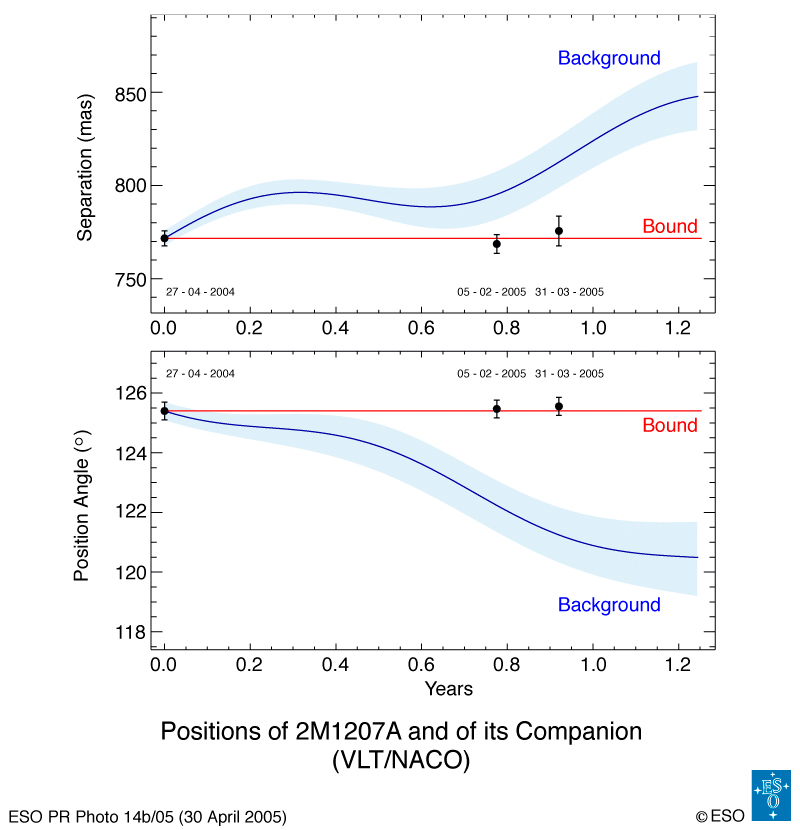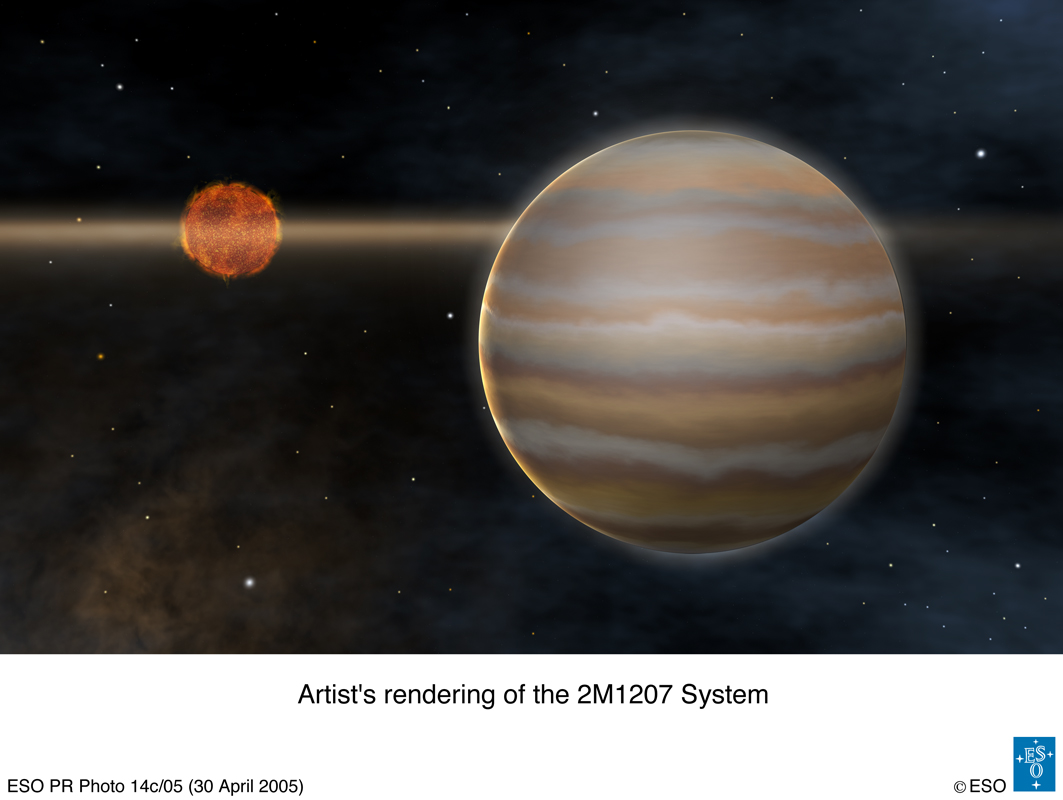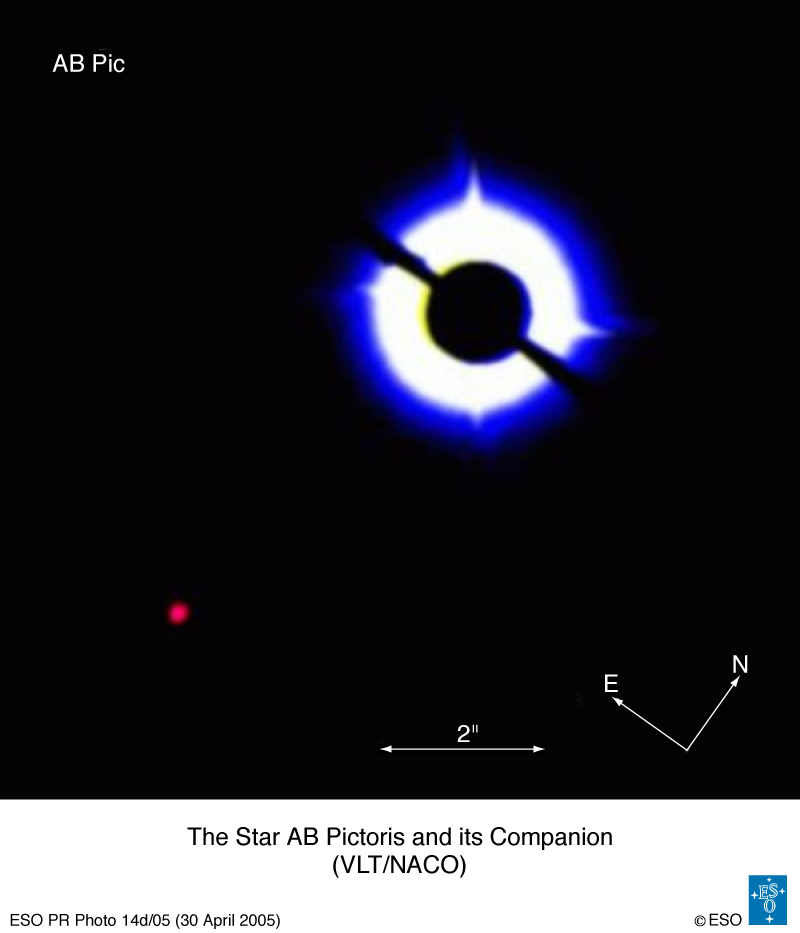Astronomers Confirm the First Image of a Planet Outside of Our Solar System[1]
In February and March of this year, the astronomers took new images of the young brown dwarf and its giant planet companion with the state-of-the-art NACO instrument on ESO's Very Large Telescope in northern Chile. The planet is near the southern constellation of Hydra and approximately 200 light years from Earth.
"Our new images show convincingly that this really is a planet, the first planet that has ever been imaged outside of our solar system," tells Gael Chauvin, astronomer at ESO and leader of the team of astronomers who conducted the study.
"The two objects - the giant planet and the young brown dwarf - are moving together; we have observed them for a year, and the new images essentially confirm our 2004 finding," says Benjamin Zuckerman, UCLA professor of physics and astronomy, member of NASA's Astrobiology Institute, and a member of the team. "I'm more than 99 percent confident." The separation between the planet and the brown dwarf is 55 times the separation of the Earth and Sun.
Anne-Marie Lagrange, another member of the team from the Grenoble Observatory in France, looks towards the future: "Our discovery represents a first step towards one of the most important goals of modern astrophysics: to characterize the physical structure and chemical composition of giant and, eventually, terrestrial-like planets."
Last September, the same team of astronomers reported a faint reddish speck of light in the close vicinity of a young brown dwarf (see ESO PR 23/04). The feeble object, now called 2M1207b, is more than 100 times fainter than the brown dwarf, 2M1207A. The spectrum of 2M1207b presents a strong signature of water molecules, thereby confirming that it must be cold. Based on the infrared colours and the spectral data, evolutionary model calculations led to the conclusion that 2M1207b is a 5 Jupiter-mass planet. Its mass can be estimated also by use of a different method of analysis, which focuses on the strength of its gravitational field; this technique suggests that the mass might be even less than 5 Jupiters.
At the time of its discovery in April 2004, it was impossible to prove that the faint source is not a background object (such as an unusual galaxy or a peculiar cool star with abnormal infrared colours), even though this appeared very unlikely. Observations with the Hubble Space Telescope, obtained in August 2004, corroborated the VLT/NACO observations, but were taken too soon after the NACO ones to conclusively demonstrate that the faint source is a planet.
 |
The new observations show with high confidence that the two objects are moving together and hence are gravitationally bound.
"Given the rather unusual properties of the 2M1207 system, the giant planet most probably did not form like the planets in our solar system," says Gael Chauvin. "Instead it must have formed the same way our Sun formed, by a one-step gravitational collapse of a cloud of gas and dust."
The paper describing this research has been accepted for publication in Astronomy and Astrophysics.
The same European/American team has had another paper just accepted for publication in Astronomy & Astrophysics; this paper reports the imaging discovery with the same VLT/NACO instrumentation of a lightweight companion to AB Pictoris, a young star located about 150 light years from Earth. The estimated mass of the companion is between 13 and 14 times the mass of Jupiter, which places the companion right on the border line between massive planets and the lowest mass brown dwarfs.
More information
Broadcast quality video material is available with this press release. It is available on the anonymous ftp server ftp.eso.org (user: anonymous) at pub/general/hboffi n/ : two files are available: STATEMENT.mov is an interview in English with Dr. Gael Chauvin (ESO) while ANIMATION.mov is a computer animation showing the 2M120 7 system. A preview of both files is available as vid-02-05.mov.
PR
Photo
14a/05: The Brown Dwarf 2M1207 and its
Planetary Companion (VLT/NACO)
PR
Photo
14b/05: Position of 2M1207A and of its
Companion at three epochs
(VLT/NACO)
PR
Photo
14c/05: Artist's rendering of the
2M1207 System
PR
Photo
14d/05: The Star AB Pictoris and its
Companion (VLT/NACO)
Video
Clip
02/05: The First Image of an Exoplanet
Confirmed
Note
[1]: This is a coordinated ESO/UCLA/CNRS Press ReleaseContacts
Gael ChauvinESO-Santiago
Chile
Phone: +56-2-463-3063
Email: gchauvin@eso.org
Ben Zuckerman
UCLA
Los Angeles, USA
Phone: +1-310-8259338
Email: ben@astro.ucla.edu
Anne-Marie Lagrange
LAOG
Grenoble, France
Phone: +33-1-44964377
Email: anne-marie.lagrange@obs.ujf-grenoble.fr
ESO Media Contacts are on
the Public
Affairs
Dept. Contact page.
Last Update: 18.04.07 ©ESO




